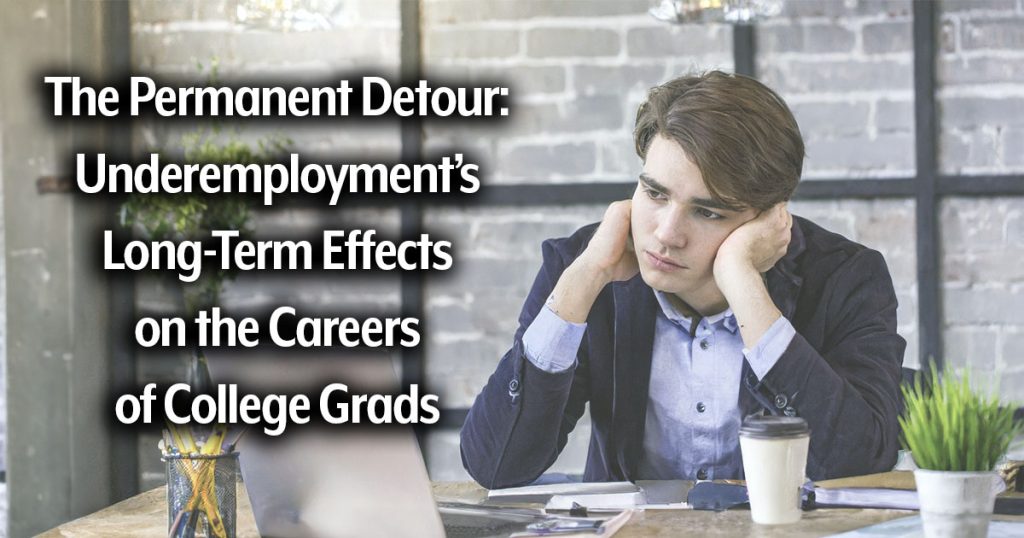Underemployment is a critical issue affecting many college graduates.
The study “The Permanent Detour: Underemployment’s Long-Term Effects on the Careers of College Grads” is by Burning Glass Technologies and the Strada Institute for the Future of Work. It examines the long-lasting impacts of underemployment on career trajectories.
This report provides insights into how initial job placements can influence long-term career success and offers recommendations for addressing these challenges.
Study Overview and Methodology
Burning Glass Technologies and the Strada Institute for the Future of Work conducted an extensive analysis of the underemployment landscape. They examined the career paths of millions of college graduates to understand the long-term effects of underemployment.
The study focused on the types of jobs graduates initially secured and tracked their career progress over time to identify patterns and impacts.
How to Cite the Study
When referencing the findings, use this format: Burning Glass Technologies & Strada Institute for the Future of Work. (2018). The Permanent Detour: Underemployment’s Long-Term Effects on the Careers of College Grads. Retrieved from https://lerna.courses/wp-content/uploads/permanent_detour_underemployment_report.pdf
Key Observations and Findings

Long-term impact of underemployment (Page 5)
Graduates who start in underemployed positions are five times more likely to remain underemployed five years later. This highlights the critical importance of securing a good first job.
Initial job placement has a profound impact on long-term career prospects. Those who begin in roles that do not require their degree struggle to move into positions that match their education level. This is particularly alarming given that 66% of graduates remain underemployed ten years later.
Underemployment rates among graduates (Page 6)
Approximately 43% of college graduates are underemployed in their first job. This figure underscores the prevalence of underemployment among new graduates.
The high rate of underemployment reflects the mismatch between educational attainment and job market demands. Many graduates end up in roles that do not utilize their skills and education. This figure is higher for recent graduates, showing a stark reality for those entering the workforce.
Gender disparities in underemployment (Page 8)
Women are more likely to be underemployed than men, with significant disparities evident in many fields. For instance, female graduates are nearly 10 percentage points more likely to be underemployed than their male counterparts.
Gender disparities in underemployment highlight the need for targeted interventions. Addressing these gaps can help improve career outcomes for female graduates. Specific attention is required in supporting women into roles that fully utilize their qualifications.
Effects on earnings (Page 9)
Underemployed graduates earn, on average, 27% less than their adequately employed peers. This earnings gap persists over time, affecting financial stability and career growth.
The earnings impact of underemployment is substantial. Graduates who do not secure appropriate roles face long-term financial disadvantages. Over a career, this can result in significantly lower lifetime earnings, contributing to broader economic inequalities.
Industry-specific findings (Page 10)
STEM graduates are less likely to be underemployed compared to non-STEM graduates. Fields such as engineering and computer science show lower rates of underemployment. For example, only 20% of engineering graduates face underemployment compared to higher rates in other fields.
STEM fields offer better alignment between education and job opportunities. Non-STEM graduates face greater challenges in finding roles that match their qualifications. This disparity emphasizes the importance of career guidance and support for students in non-STEM disciplines.
Importance of the first job (Page 11)
The first job sets the stage for future career opportunities. Graduates who start in roles that match their education are more likely to continue advancing in their careers. Conversely, those underemployed initially are less likely to progress.
Securing a good first job is crucial for career success. Graduates should seek roles that utilize their skills and education to ensure better long-term outcomes. Failure to do so can result in being five times more likely to remain underemployed after five years.
Recommendations for institutions (Page 12)
Educational institutions should focus on better aligning curricula with job market demands. Providing career services and support can help graduates secure appropriate employment. Schools must bridge the gap between academic training and practical skills required in the job market.
Institutions play a key role in addressing underemployment. By aligning education with market needs and offering robust career services, they can improve graduate outcomes. Institutions should also track graduate outcomes to continually refine and adapt their programs.
Recommendations for employers (Page 13)
Employers should recognize the value of recent graduates and offer opportunities that match their skills. Developing clear career pathways can help retain talent and reduce underemployment. Companies should also consider partnerships with educational institutions to ensure a steady pipeline of appropriately trained graduates.
Employers can help mitigate underemployment by offering roles that utilize graduates’ skills. Clear career pathways and development opportunities are essential. By investing in young talent, employers can build a more capable and loyal workforce.
Recommendations for policymakers (Page 14)
Policymakers should support initiatives that bridge the gap between education and employment. Investing in programs that enhance employability can reduce underemployment rates. This includes funding for career services, internships, and apprenticeships.
Policymakers have a critical role in addressing underemployment. Supporting education-employment alignment and employability programs can improve career outcomes for graduates. Policies should focus on creating a robust support system for new graduates entering the job market.
Details of Data, Statistics, and Findings

For more detailed insights and data, access the full PDF document.
These findings highlight the significant challenges of underemployment and its long-term effects on graduates. They emphasize the need for strategic actions by educational institutions, employers, and policymakers to address this critical issue.
Other Titles by Burning Glass
Moving the Goalposts by Burning Glass Technologies. This report examines the increasing demand for bachelor’s degrees in the job market, focusing on the trend of upcredentialing. It highlights the impact on various job sectors, hiring difficulties, and the broader implications for the workforce. Download the PDF for detailed insights.
State of Cybersecurity Hiring by Burning Glass Technologies. This report analyzes the cybersecurity job market, highlighting rapid job growth, high demand for skills, and challenges in filling roles. It covers education and certification requirements, emerging skills, and industry-specific needs. Download the PDF for detailed insights.
